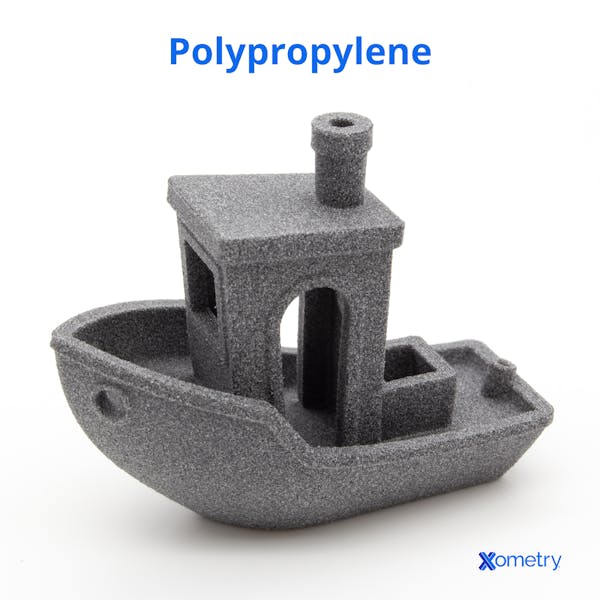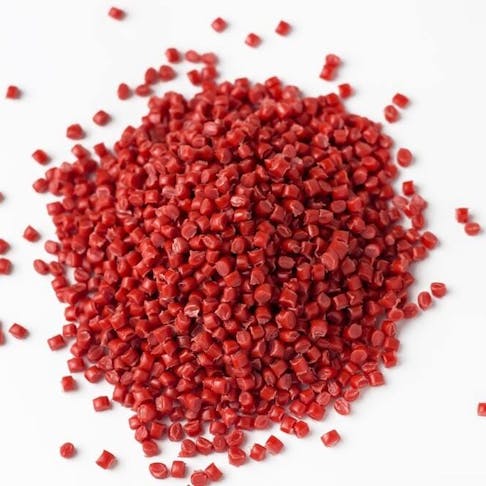PP (Polypropylene) is a semicrystalline thermoplastic. It is the second most commonly used commodity plastic after polyethylene. It is primarily used in packaging for food and consumer goods, due to its favorable balance of properties and low cost. PP was first synthesized in 1951 by J. Paul Hogan and Robert Banks, employees at Phillips Petroleum. It was later commercialized with the help of German chemist Karl Rehn and Italian scientist Giulio Natta, whose work in polymer stereochemistry enabled the mass production of isotactic polypropylene.
PP’s use in 3D printing is not so widespread. It can be challenging to print due to its propensity to warp. PP needs a heated build volume and a relatively high build plate temperature. PP 3D printing filament can be supplied in translucent or colored varieties or filled with various additives like glass fiber, talc powder, or an ethylene copolymer. The three main advantages of 3D printing with polypropylene are its excellent fatigue resistance, good chemical resistance, and good interlayer bonding. This article will discuss the general characteristics of polypropylene, along with its composition, properties, and limitations, and compare it with other 3D printing filaments.
What is PP 3D Printing?
3D printing, also known as additive manufacturing, is the process of creating a physical object by building it layer by layer from digital design data, typically through the deposition of melted thermoplastic materials. It is gaining acceptance and market share as technical difficulties with printing this thermoplastic have been solved. As such, Polypropylene (PP) 3D printing involves using polypropylene filament in additive manufacturing to produce durable, flexible parts. While historically difficult to print due to issues like warping and poor bed adhesion, recent advances in material formulations and printer settings have significantly improved its reliability. PP is especially valued for its excellent fatigue resistance, making it ideal for functional components like living hinges. Its chemical resistance to acids, bases, and solvents at room temperature makes it suitable for applications in the medical and automotive industries.
For more information, see our guide on 3D printing.

What is the Composition of PP Filament?
Polypropylene is a semicrystalline monomer with the formula (C3H6)n. It is produced via chain-growth polymerization of propene. Polypropylene is available as a homopolymer (general-purpose grade), a block copolymer (incorporates between 5 and 15% ethylene), and a random copolymer (incorporates randomly arranged co-monomers along the main polypropylene molecular chain and includes between 1 and 7 % ethylene). Black titanium oxide pigment can be added to color the plastic and improve its UV (Ultraviolet) light resistance. Glass-filled polypropylene filament is available to increase standard polypropylene's heat deflection temperature at the expense of impact resistance.
What Are the Properties of PP Filament?
Some key mechanical and thermal properties of PP 3D printing filament are listed below:
- Polypropylene has a melting temperature of 130°C and a heat deflection temperature of 64.1°C.
- One of the most critical properties of PP is its chemical stability. This chemical stability means that it is resistant to many different chemicals, including acids and alkalis.
- Polypropylene can resist impact loading with braking or shattering.
- Polypropylene can withstand millions of stress cycles without failing.
Comparison of PP Filament Properties
Table 1 lists the properties of PP 3D printing filament in comparison to a range of other high-performance filaments:
| Property | PP | ABS | PETG |
|---|---|---|---|
Property Tensile Modulus (MPa) | PP 234 ± 16 | ABS 1699 ± 113 | PETG 1711 ± 45 |
Property Tensile Stress @ Yield (MPa) | PP 8.6 ± 0.4 | ABS 38.1 ± 0.3 | PETG 46.2 ± 0.8 |
Property Elongation @ Yield (%) | PP 18.7 ± 3.0 | ABS 4.1 ± 0.1 | PETG 5.9 ± 0.1 |
Property Flexural Modulus (MPa) | PP 250 ± 9 | ABS 1317 ± 28 | PETG 1489 ± 25 |
Property Flexural Strength (MPa) | PP 9.4 ± 0.3 | ABS 21.5 ± 1.8 | PETG 50 ± 3.5 |
Property Charpy Impact Strength (kJ/m2) | PP 49.1 ± 3.2 (Notched) | ABS 1.5 ± 0.1 (Hinge) | PETG 7.9 ± 0.6 (Notched) |
Property Hardness (Shore D) | PP 42 | ABS 55–70 | PETG 55–70 |
Property Heat Deflection Temperature (0.455 MPa) | PP 64.1 ± 3.6 | ABS 86.6 ± 0.4 | PETG 76.2 ± 0.8 |
Property Glass Transition Temperature (°C) | PP -20 | ABS 100.5 | PETG 77.4 |
Property Melting Temperature (°C) | PP 130.6 | ABS N/A (Amorphous polymer) | PETG 230-250 |
Table Credit: Comparison of PP vs ABS vs PETG
Why is PP used in 3D printing?
While PP does not offer high tensile strength compared to engineering-grade polymers, it has several distinctive properties that make it valuable for specific use cases. PP is particularly suitable for applications such as living hinges, translucent or semi-flexible containers, and wearable device components like straps, due to its excellent fatigue resistance and low moisture absorption. It also exhibits high chemical resistance to acids, bases, and many solvents, making it ideal for laboratory or industrial environments. In addition, PP is widely used in the medical and automotive industries, where its biocompatibility, resistance to sterilization processes, and lightweight properties are advantageous. Like many thermoplastics, polypropylene is recyclable, although 3D-printed PP parts can be more challenging to recycle due to small part sizes and material contamination. Nevertheless, its thermoplastic nature allows it to be remelted and reused in closed-loop manufacturing systems.
How to Use PP in 3D Printing
PP 3D printing filament is one of the more difficult thermoplastics to print. However, if the correct settings are used, there is no reason why excellent results can’t be achieved. Listed below are some tips for printing with polypropylene:
- PP 3D printing filament does not readily bond to an unprepared build plate. Packaging tape applied to the build plate will create a good bond to the first printed layer, as will particular specialized glue sticks, such as Magigoo PP.
- Polypropylene will easily warp during printing if the print environment is not maintained at a relatively high temperature of 45°C. Therefore, an enclosed print volume is recommended.
- A “raft” is a printed base on top of which an actual part can be printed. Using a raft will protect the base layer of the part, as sometimes the part will bond too well to a properly prepared build plate, and removing the part can damage its base. A raft can be easily removed by simply pulling it off.
What Are the Best Configuration Settings for PP 3D Printing?
While a heated build volume and proper bed adhesion techniques significantly improve the printing success rate with PP, optimizing the printer settings is equally important. The parameters listed below serve as a general guideline, but for the best results, always consult the technical datasheet or manufacturer’s recommendations for your specific polypropylene filament grade. Polypropylene is known for its low surface energy, which makes adhesion challenging. Techniques such as using a polypropylene build sheet, packing tape (PP-based), or special adhesion primers (e.g., Magigoo PP) are recommended for reliable bed adhesion.
The following data in Table 2 are some of the important printer settings to determine and set before printing with polypropylene filament:
| Printer Setting | Value |
|---|---|
Printer Setting Bed temperature | Value 85-100°C |
Printer Setting Nozzle temperature | Value 205-220°C |
Printer Setting Print speed | Value 30-90 mm/s (slower speed produces better results) |
Printer Setting Retraction distance | Value 6.5 mm for Bowden extruders; 3 mm for direct-drive systems |
Printer Setting Infill Density | Value 20% |
What is the Best PP 3D Print Speed?
The recommended printing speed for PP typically ranges from 30 mm/s to 60 mm/s, depending on the printer setup, filament brand, and desired part quality. While it is possible to print at speeds up to 90 mm/s, doing so may introduce dimensional inaccuracies and layer adhesion issues if not properly controlled. Lower print speeds (30-50 mm/s) are generally preferred for improved dimensional stability and surface quality, especially when printing parts that require tight tolerances or minimal warping. Higher speeds, while reducing overall print time, can lead to thermal inconsistencies and warping due to PP’s high shrinkage rate.
Increasing print speed can sometimes improve interlayer bonding, as it reduces the cooling time between layer depositions, allowing the previous layer to remain warm and better bond with the next. However, this benefit is highly dependent on precise temperature control and effective part cooling management, which can be difficult with PP due to its low surface energy and poor bed adhesion. If high-speed printing is attempted, it is essential that the 3D printer is mechanically rigid to minimize vibration and resonance. Excessive motion or wobble during high-speed operation can significantly degrade print quality, particularly in taller or geometrically complex parts.
What is the Melting Temperature of PP Filament?
The melting temperature of polypropylene filament is typically in the range of 160°C to 170°C, though this can vary depending on the manufacturer and any additives included in the formulation. While pure isotactic PP has a melting point of approximately 130.6°C, most commercial 3D printing filaments use modified versions to enhance printability, which raises the effective melting range. In practice, PP is usually extruded at 220°C to 250°C to ensure proper flow and interlayer bonding. Always consult the technical data sheet (TDS) of the specific filament to determine the correct temperature settings for optimal results.
Is a Heated Printing Bed Required When Printing With PP?
Yes, a heated printing bed is required when printing with polypropylene. Failure to print with a bed heated to at least 85°C will cause bed plate adhesion problems, resulting in a failed print.
What is a Good Wall Thickness for 3D Printing PP?
The optimal wall thickness for 3D printing PP depends on the intended application. Still, a general guideline is to use a minimum wall thickness of around 1 mm for standard functional parts. This provides sufficient strength and rigidity while minimizing warping. For specialized features like living hinges, PP's excellent fatigue resistance allows for much thinner sections—as low as 0.4 mm—to maintain flexibility and durability over repeated cycles. However, walls thinner than 0.8 mm may require fine-tuned printer settings, including proper cooling, slower speeds, and high-precision extrusion. As always, design considerations should align with the filament manufacturer’s guidelines for best performance.
What is a Good Wall Density for 3D Printing PP?
The optimal infill density for a non-functional mockup polypropylene 3D printed part is 20%. However, this density must be adjusted depending on the intended application. Load-bearing applications may require 50-80% infill density. The standard grid-type infill will be sufficient for the majority of applications.
What is the Difference Between PP and PLA in 3D Printing?
PLA (Polylactic Acid) is a rigid and brittle material with poor fatigue resistance compared to polypropylene. However, PLA is significantly cheaper than PP 3D printing filament and is much easier to print.
What is the Difference Between PP and ABS in 3D Printing?
ABS (acrylonitrile butadiene styrene) has significantly better mechanical strength than polypropylene 3D printer filament. However, both materials are prone to warping and require heated build volumes during printing.
What is the Difference Between PP and PET in 3D Printing?
There is considerable overlap in the applications of PP and PET (Polyethylene Terephthalate). For example, both are used to safely store food and liquids. PP and PET also have similar temperature resistance and stiffness properties.
Frequently Asked Questions About PP 3D Printing
Is PP Biodegradable?
Polypropylene filament for 3D printing is not biodegradable and must be recycled in an industrial facility.
Is PP Recyclable?
Like most thermoplastics, polypropylene is recyclable.
Is PP Hygroscopic?
Polypropylene 3D printing filament is not hygroscopic. It does not readily absorb moisture.
Summary
This article presented PP 3D printing filament, explained what it is, and discussed different factors to consider when using it in 3D printing. To learn more about PP 3D printing filament, contact a Xometry representative.
Xometry provides a wide range of manufacturing capabilities, including 3D printing and other value-added services for all of your prototyping and production needs. Visit our website to learn more or to request a free, no-obligation quote.
Disclaimer
The content appearing on this webpage is for informational purposes only. Xometry makes no representation or warranty of any kind, be it expressed or implied, as to the accuracy, completeness, or validity of the information. Any performance parameters, geometric tolerances, specific design features, quality and types of materials, or processes should not be inferred to represent what will be delivered by third-party suppliers or manufacturers through Xometry’s network. Buyers seeking quotes for parts are responsible for defining the specific requirements for those parts. Please refer to our terms and conditions for more information.


